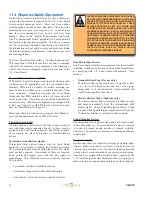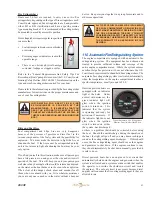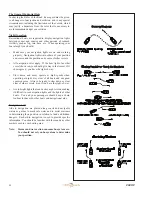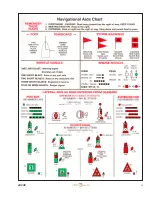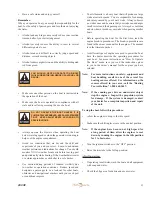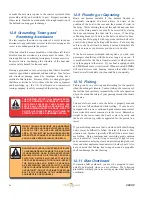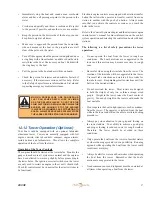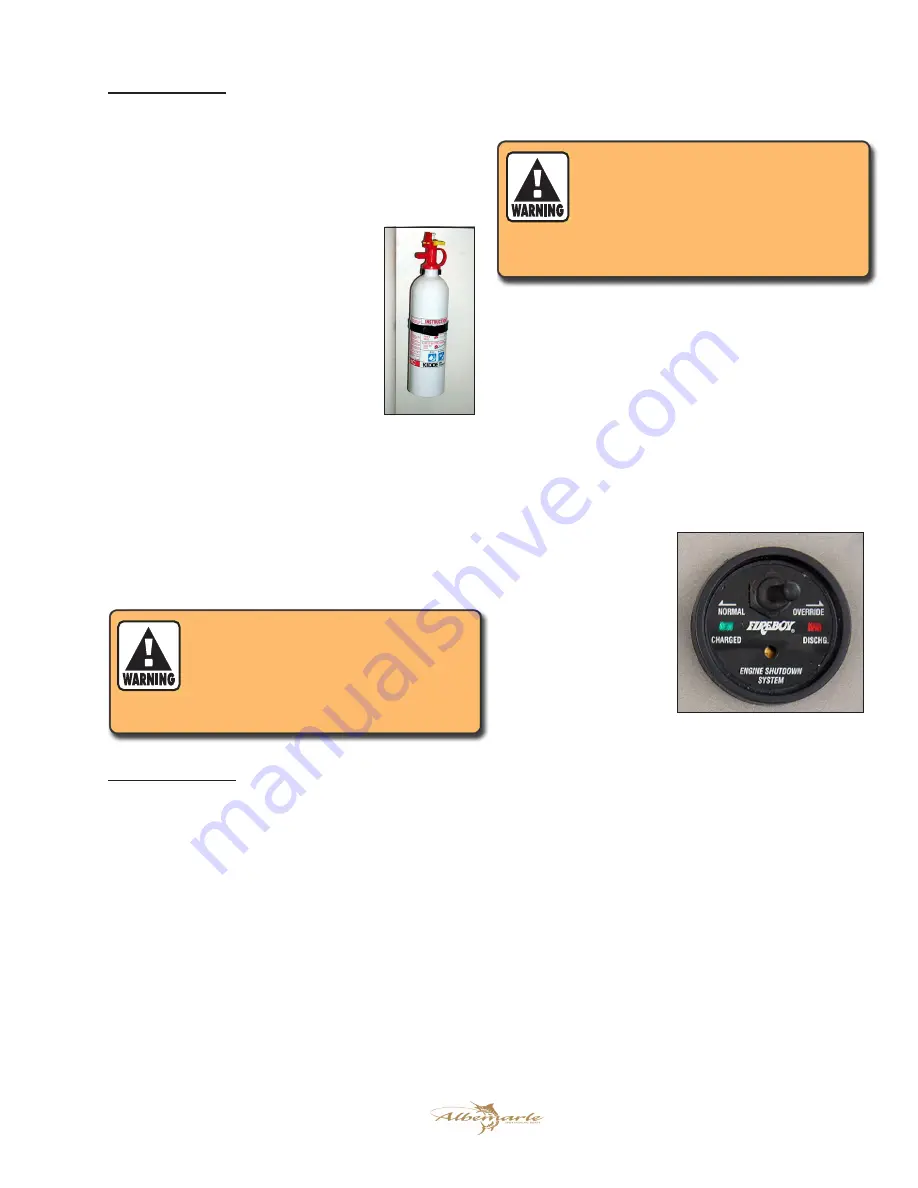
83
290 XF
Fire Extinguishers
Boats over 26 feet are required to carry one or two fire
extinguishers, depending on the type of fire extinguishers used.
Coast Guard approved fire extinguishers are hand‑portable,
either B‑I or B‑II classification and have a specific marine
type mounting bracket. It is recommended the extinguishers
be mounted in a readily accessible position.
Fire extinguishers require regular inspections
to ensure that:
•
Seals & tamper indicators are not broken
or missing.
•
Pressure gauges or indicators read in the
operable range.
•
There is no obvious physical damage,
corrosion, leakage or clogged nozzles.
Refer to the “Federal Requirements And Safety Tips For
Recreational Boats” pamphlet or contact the U.S. Coast Guard
Boating Safety Hotline, 800-368-5647, for information on the
type and size fire extinguisher required for your boat.
Please refer to the information provided by the fire extinguisher
manufacturer for instructions on the proper maintenance and
use of your fire extinguisher.
INFORMATION FOR AGENT FE-241 FIRE
E X T I N G U I S H E R S I S P ROV I D E D b Y T H E
MANUFACTURER. IT IS ESSENTIAL THAT YOU
READ THE INFORMATION CAREFULLY AND
COMPLETELY UNDERSTAND THE SYSTEM, IN
THEORY AND OPERATION, bEFORE USING YOUR
bOAT.
Bilge and Fuel Fires
Fuel compartment and bilge fires are very dangerous
because of the presence of gasoline or diesel fuel in the
various components of the fuel system and the possibility for
explosion. You must make the decision to fight the fire or
abandon the boat. If the fire cannot be extinguished quickly
or it is too intense to fight, abandoning the boat may be your
only option.
If you find yourself in this situation, make sure all passengers
have a life preserver on and go over the side and swim well
upwind of the boat. This will keep you and your passengers
well clear of any burning fuel that could be released and spread
on the water as the boat burns or in the event of an explosion.
When clear of the danger, check about and account for all
those who were aboard with you. Give whatever assistance
you can to anyone in need or in the water without a buoyant
device. Keep everyone together in a group for morale and to
aid rescue operations.
ALL TYPES OF FUEL CAN EXPLODE. IN THE EVENT
OF A FUEL COMPARTMENT OR bILGE FIRE, YOU
MUST MAKE THE DIFFICULT DECISION TO FIGHT
THE FIRE OR AbANDON THE bOAT. YOU MUST
CONSIDER YOUR SAFETY, THE SAFETY OF YOUR
PASSENGERS, THE INTENSITY OF THE FIRE AND
THE POSSIbILITY OF AN EXPLOSION IN YOUR
DECISION.
11.5 Automatic Fire Extinguishing System
The engine compartment is equipped with an automatic fire
extinguishing system. The equipment has been chosen and
located to provide sufficient volume and coverage of the
entire engine compartment area. While the system ensures
excellent bilge fire protection, it does not eliminate the U.S.
Coast Guard requirement for hand held fire extinguishers. The
automatic fire extinguishing system is activated automatically
when the temperature in the engine compartment reaches a
specific temperature, usually around 165 0 F.
Gasoline powered boats are
equipped with an indicator
light at the helm. Under
normal circumstances, the
green indicator light will
glow when the ignition
switch is turned on. This
indicates that the system
is operating and ready for
activation if necessary. If
the indicator light does not
glow when the ignition
switch is turned on, either
the system has discharged
or there is a problem that should be corrected before using
the boat. Should the unit discharge during the operation of
the boat, the light will go off and you may hear a rushing air
sound as the extinguishing agent discharges. If this should
occur, the fire extinguishing agent should cause the engines
and generator to shut down. If the engines continue to run,
they should immediately be shut down manually, provided it
is safe to do so.
Diesel powered boats have an engine cut out circuit that
automatically shuts down the engines and generator when the
system is activated and a system override switch that enables
the operator to override the shutdown circuit and restart
the engines. The cut out circuit is necessary because diesel
engines will consume the fire extinguishing agent if they are
allowed to run.
Typical Automatic Fire Extinguisher
Monitor Panel & Override Switch
Summary of Contents for 290 EXPRESS FISHERMAN
Page 2: ...290 XF 2 Print Date 4 07 2009 THIS PAGE WAS LEFT BLANK INTENTIONALLY...
Page 6: ...290 XF 6 THIS PAGE WAS LEFT BLANK INTENTIONALLY...
Page 8: ...290 XF 8 THIS PAGE WAS LEFT BLANK INTENTIONALLY...
Page 10: ...290 XF 10 THIS PAGE WAS LEFT BLANK INTENTIONALLY...
Page 22: ...290 XF 22 THIS PAGE WAS LEFT BLANK INTENTIONALLY...
Page 28: ...290 XF 28 THIS PAGE WAS LEFT BLANK INTENTIONALLY...
Page 34: ...290 XF 34 THIS PAGE WAS LEFT BLANK INTENTIONALLY...
Page 56: ...290 XF 56 THIS PAGE WAS LEFT BLANK INTENTIONALLY...
Page 80: ...290 XF 80 THIS PAGE WAS LEFT BLANK INTENTIONALLY...
Page 88: ...290 XF 88 THIS PAGE WAS LEFT BLANK INTENTIONALLY...
Page 91: ...91 290 XF...
Page 104: ...290 XF 104 THIS PAGE WAS LEFT BLANK INTENTIONALLY...
Page 110: ...290 XF 110 THIS PAGE WAS LEFT BLANK INTENTIONALLY...
Page 112: ...290 XF 112 MAINTENANCE LOG Hours Date Dealer Service Repairs...
Page 113: ...113 290 XF MAINTENANCE LOG Hours Date Dealer Service Repairs...
Page 114: ...290 XF 114 MAINTENANCE LOG Hours Date Dealer Service Repairs...
Page 115: ...115 290 XF MAINTENANCE LOG Hours Date Dealer Service Repairs...
Page 116: ...290 XF 116 MAINTENANCE LOG Hours Date Dealer Service Repairs...
Page 118: ...290 XF 118 THIS PAGE WAS LEFT BLANK INTENTIONALLY...
Page 119: ...119 290 XF Appendix C BOATING ACCIDENT REPORT...
Page 120: ...290 XF 120 BOATING ACCIDENT REPORT...
Page 121: ...121 290 XF...
Page 122: ...290 XF 122 THIS PAGE WAS LEFT BLANK INTENTIONALLY...
Page 133: ...133 290 XF THIS PAGE WAS LEFT BLANK INTENTIONALLY...
Page 134: ...Albemarle Boats 140 Midway Dr P O Box 349 Edenton NC 27932...














